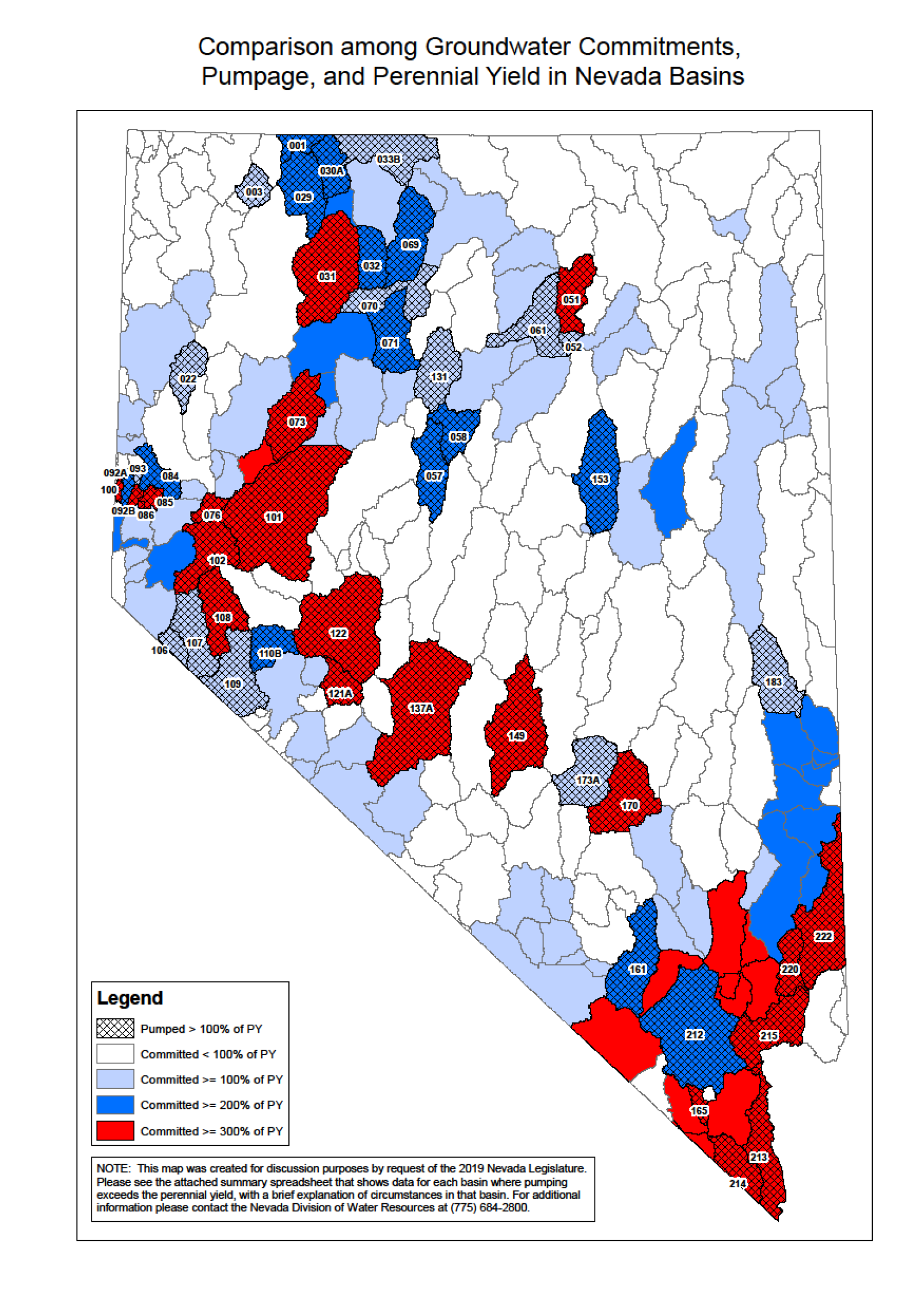
Perennial yield is the maximum amount of groundwater that can be salvaged each year over the long term without depleting the groundwater reservoir.
In a state where we rely in perennial yield as a foundational principle, Nevada’s current status of over-committed, over-pumped basins should cause serious concern.
A map prepared by the Nevada Division of Water Resources (view at the end of this article) shows in colorful context that there are a number of the state’s 256 groundwater basins which are being depleted beyond their capacity through over-commitment and over-pumping. Doing the rough math and using the map as a point of reference, just under 40 percent of Nevada’s groundwater basins are committed by more than 100 percent of the identified perennial yield, with some of this category reaching as far as 200 and 300 percent. Out of the 256 total basins in the state, over 19 percent are over-pumped.
Responding to the different circumstances throughout the state will require a variety of actions. First, there needs to be an understanding of what is happening in the groundwater basins on the local level. Not all of the same conditions are relevant in the various groundwater basins which need attention. In some cases, the function of how water use is taking place, including surface water use and how that translates to groundwater interaction might result in less of a reduced reason for concern.
Other possible actions might best be addressed by limiting any additional allocation of water, preventing further expansion of basins currently beyond the verge of being over-committed. Local activities could also address over-pumping contention with better reporting on how much water is actually being used. (In many cases, the full authorized water for that area is not being utilized.)
Within Nevada water law there are additional provisions available for these problem areas. In recent years, attention has been focused on fully completing the necessary proof of beneficial use and managing the timeframe and process for those extensions. While not currently used for groundwater, there is an option for curtailment by priority that is provided for in state law.
Before considering further changes to state law, getting an updated handle on where we actually are today, through a basin-by-basin base line inventory would be in order. This type of analysis should use the most modern scientific techniques in determining whether perennial yield fits with the historical assessment made in setting perennial yield. It might also be necessary to re-evaluate if circumstances have changed the ability for perennial yield to be capable of remaining as a legitimate level of use.
Nevada’s Interim Legislative Finance Committee has granted the authority for the Division of Water Resources to use $6.4 million of federal American Rescue Plan Act (ARPA) for the purpose of funding a Water Resource Initiative to update data to inform water resource management. What this initiative looks like in detail is not totally clear, but the general understanding is that it will involve a fresh look at groundwater perennial yield numbers.
Whether the $6.4 million is sufficient to do the necessary job has been a point of contention with any number of persons believing that it won’t be sufficient to complete the task that should be carried out. Learning more specifics of what’s in the details for the Water Resource Initiative is essential and there should be an understanding on the part of the Legislature that if more funding will be necessary to get the complete picture, they need to be prepared to fund the completion of the essential work.
Nevada Farm Bureau policy positions stress the importance of having current, scientifically based data that provides the baseline information needed to understand where things stand on a basin-by-basin basis. The organization’s policy also supports addressing over-appropriated groundwater basins with solutions oriented to bring water rights and water being pumped into balance with perennial yields. Ongoing monitoring reports need to be shared with water right owners in the groundwater basin to assist in better understanding the conditions and status of their groundwater basin.
In the mix of possible solutions, Nevada Farm Bureau policy supports a buyout/retirement program as a means to solve over-appropriation, as long as it does not significantly diminish another property owner’s property rights.
As alternative actions are considered and pursued, Farm Bureau’s top priority is adherence to the state’s Prior Appropriation Doctrine. Short-cuts or workarounds that diminish the rights of senior water right owners need to have the agreement of those senior water right owners, and anything less constitutes an inappropriate taking of private property.
Along with determining the base-line scenario on a local basis there a needs to be a commitment on the part of the local stakeholders being impacted by the conditions that they are facing with a willingness to take some control of their situation. Once again recognition of senior water right owners is essential.
Those who are more junior in water right status cannot just run-over other people’s rights and trample the property rights of more senior water right owners. Nevada’s priority system should not be subject to being tossed out because there are more people who are junior than there are senior water right owners. If you aren’t interested in recognizing other people’s rights – what makes you believe that your rights will matter to others?
The current situation will not be an easy thing to reverse. Drought conditions and increased demand don’t make it any simpler.
Having as much of an exact understanding as possible of where we are is critical in figuring out where we need to go.
By Doug Busselman | NFB Executive Vice President

